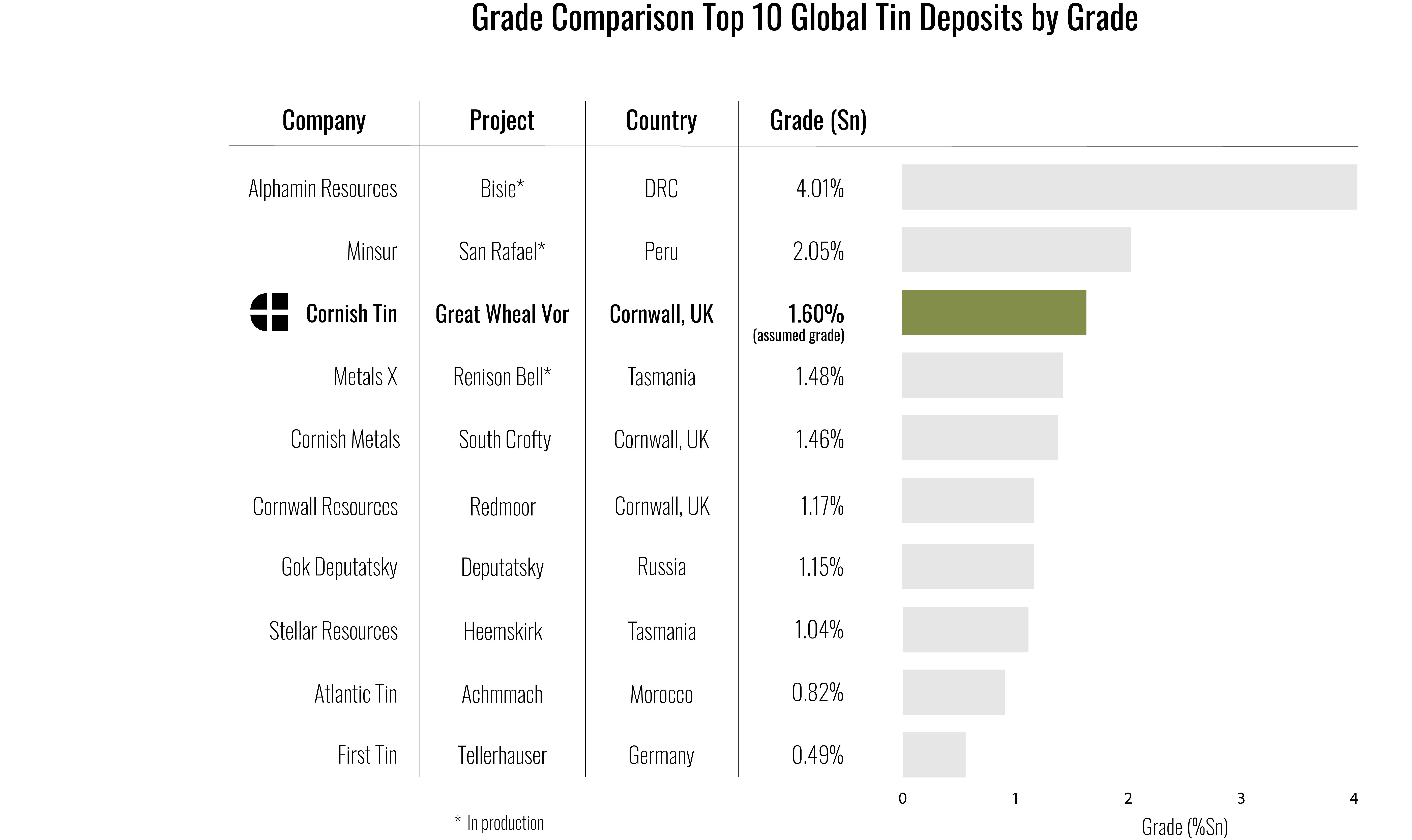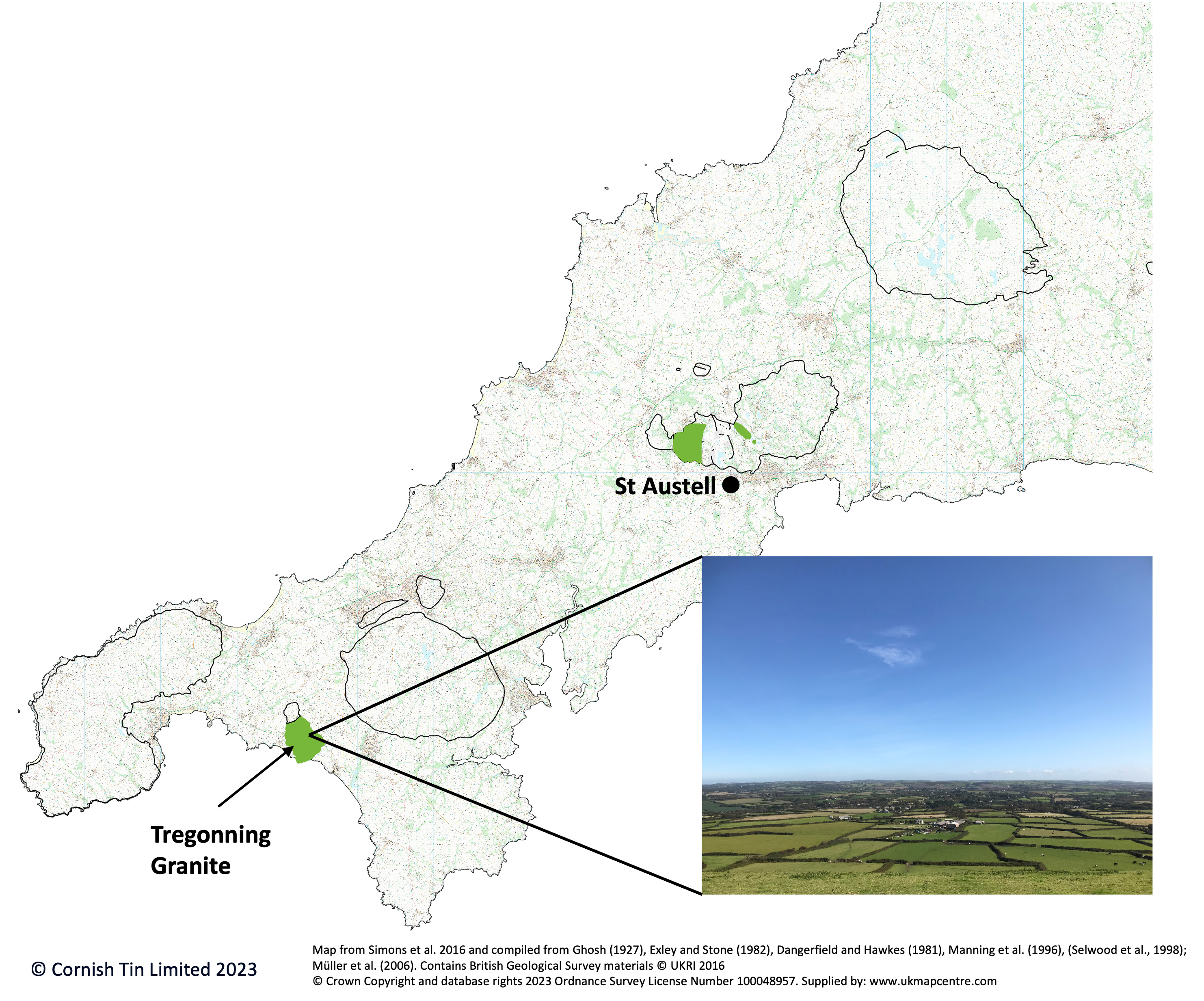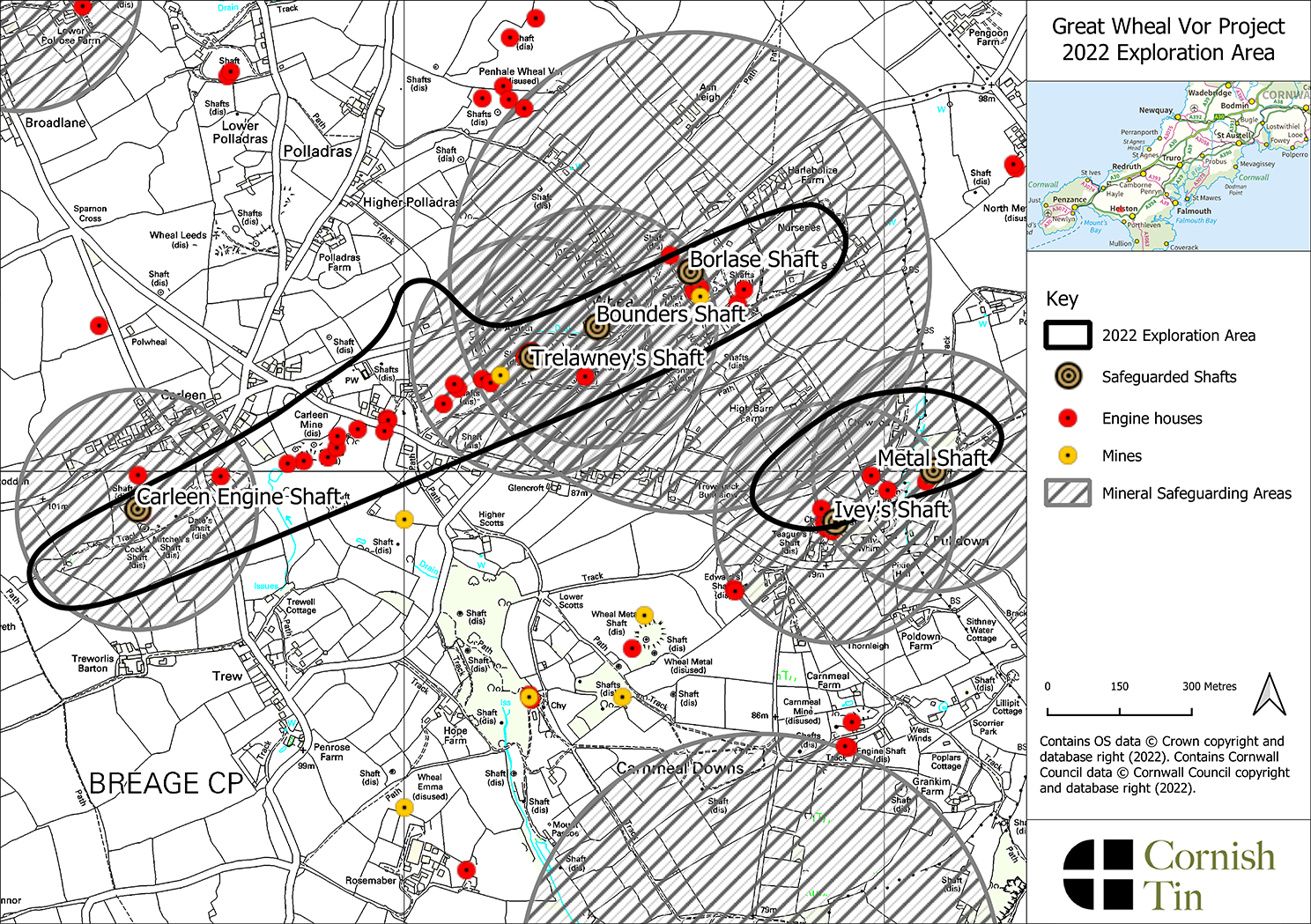One of the World's Top High Grade Tin Projects...
Our first and flagship project is The Great Wheal Vor group of 26 former producing tin and copper mines in the Mining District of Breage, Cornwall, UK.
Described in 1929 as “the richest in tin of all the Cornish mines, probably the richest tin mine which has ever been worked in the world” (Hamilton Jenkin, writing in 1929).
Historic production grades were exceptionally high, averaging over 3% Sn (tin) and peaking at over 5.5% Sn. By grade, if being mined today, it could be in the top 3 tin mines in the world. Our mineral rights cover all minerals and aggregates, including tin, copper, lithium, tungsten and geothermal energy.
Our first exploration drilling program of 2022 delivered proof of concept, with discoveries of multiple tin lodes, with grades of up to 6.28% Sn.
...and a Potential New Lithium Field for Cornwall and the UK
Granite in Cornwall which is viable for hard rock lithium mining is extremely rare. Known as G5 granite, (also called topaz granite) it accounts for only about 1.4% of all outcropping granites in Cornwall.
Of this 1.4%, approximately 54% of it comprises the Tregonning granite, a G5 granite which underlies much of our Exploration Area.
In our first exploration drilling program in 2022, we discovered enhanced lithium levels within our Exploration Area, also associated with high tin values.
An Opportunity That Has Taken 150 Years To Arrive - Why Now?
Why The Mines Closed
The mines here closed in the 1870s, not through lack of tin, but due to 20 years of litigation against illegal operators who took what they could grab, against a deadline, but left significant mineral resources still in the ground. Operations were also hampered by poor mining practices and the inability of technology at that time to extract the ore at depth.
Unified Mineral Rights
Since the mines closed about 150 years ago, no-one has been able to put together the necessary mineral rights to take this forward, until now. Our Founder has many years experience in negotiating mineral rights and has successfully secured rights for numerous companies in the UK and globally. Even with this legal background, it took 5 years to sort out legal control of the minerals.
Standardised Agreements
For the first time in history, Cornish Tin has unified it's chosen exploration areas with standard agreements with the mineral owners, giving Cornish Tin the rights over all minerals and aggregates including tin, copper, lithium, tungsten and geothermal energy.
High Grade Tin Ore
Historic production grades averaged over 3% Sn (tin), peaking at over 5.5% Sn (tin). By grade, if being mined today, it could be in the top 3 tin mines in the world.

Taking into account Trounson’s data on historic production grades (>5.5% Sn) an assumption has been made that a head grade of at least 2% Sn could be achievable by Cornish Tin. Even at this grade, the Great Wheal Vor mines would, if being mined today, be among the top three highest grade tin mines in the world: for illustrative purposes only see comparison table.
Geological Context
The Exploration Area lies in the Mining District of Breage, Cornwall, between the Tregonning granite to the west (a lithium enriched G5 granite) and the Carnmenellis granite to the east.

The Lithium Potential of the Tregonning Granite
Geological map showing the principal mineralogical and textural variations in the Cornubian Batholith
Lithium Enriched Granites in Cornwall

Lithium enriched G5 granites form a small component (~1.4%) of all outcropping granites in Cornwall
Lithium enriched G5 granite shown in pale green on map
The Tregonning granite represents ~54% of all outcropping G5 granite in Cornwall but has not previously been explored for lithium
The eastern flank of the Tregonning granite underlies our Exploration Area and outcrops along its western margin
The final 2022 drillhole (GWV22022) was designed to test a granite hosted tin intersection from the 1960s and identified significant zones of both tin and lithium mineralisation
2022 First Exploration Drilling Program: Significant Tin Intercepts
The maiden exploration drilling program of 2022 delivered proof of concept, showing that significant tin mineralisation exists beyond the extent of the historic mining. Discoveries of multiple new tin lodes with grades of up to 6.28% Sn.

Headline results confirm grade potential documented in historic records
Strong tin results so far concentrated in Vor West, Vor Central and Tregonning granite
Significant intercepts returned from multiple mineralised structures open in multiple directions
Opportunity to test extensions and grow tonnage base through further drilling
Lithium Zones Discovered in 2022 Exploration Drilling Program
Drillhole GWV22022 was designed to discover lithium in the G5 Tregonning granite, and this cross section shows that the granite roof complex is strongly enriched in both tin and lithium, with further lithium zones in the granite below

Significant tin intersections hosted within a greisen alteration zone at the granite contact
Strong lithological (1) and alteration (2) controls on lithium grade distribution in GWV22022
Petrography and X-Ray Diffraction indicate Li is primarily hosted within lithium micas
CTL 35 was a drillhole drilled by Camborne Tin Limited in the 1960's. No analysis for lithium was recorded, but CTL 35 intercepted tin at the granite contact, at a grade of 0.92% Sn
Positive National Benefits and Government Support
High Potential Opportunity for the UK
Government has recognised the important role Cornwall’s natural resources will play in achieving maximum self-sufficiency by designating mining in Cornwall as a "High Potential Opportunity".
Domestic Supply of Critical Minerals
A domestic source of critical minerals is essential if the UK is to de-risk supply chains whilst meeting ever growing demand, and mitigate tariffs on UK exports under post-Brexit Rules of Origin.
Circular Economy
Our vision is a circular economy for critical minerals within the UK, ideally with an onshore smelting hub powered by sustainable energy, as a driving force in our fight against climate change.
Resilience for the Future: The UK's Critical Minerals Strategy
The UK Government's first ever Critical Minerals Strategy, of March 2023 - link here, states that:
We are moving to a world powered by critical minerals: we need lithium, cobalt and graphite to make batteries for electric cars: silicon and tin for our electronics
UK jobs and industries rely on minerals vulnerable to market shocks, geopolitical events and logistical disruptions, at a time when global demand for these minerals is rising faster than ever
We will accelerate growth of the UK's domestic capabilities
Positive Regional Benefits and Local Support

Local Government Minerals Safeguarding
Cornwall Council Minerals Safeguarding Development Plan adopted 2018, states: “Cornwall will have a world class thriving minerals industry”. The Plan specifically safeguards the mineral resources and infrastructure in the Exploration Area from sterilisation by surface development which would conflict with mineral use of site.
Local Jobs and Careers
Cornwall is one of the poorest regions in Europe, but with investment could level up, to retake its place as Europe’s leading producer of critical metals, providing much needed careers and jobs for the working people of Cornwall. Cornish Tin's mission is to deliver a clean domestic supply of both tin and lithium for UK industry and export. As we advance towards production, Cornish Tin would provide at least 400 new jobs.
Subscribe For News Updates
Stay up to date with the latest news straight to your inbox.
We take your privacy seriously, you can unsubscribe at any time.